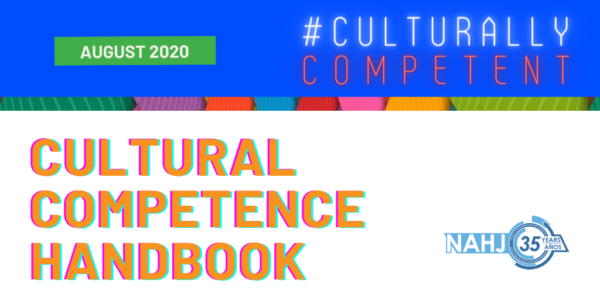 The National Association of Hispanic Journalists (NAHJ) announced Friday, August 21st the launch of a nearly 40 page Cultural Competence Handbook, that communicates the intersection of diversity, equity, and inclusion across all communities. The nonpartisan guide will be adopted by newsrooms, media, students, and academia across the U.S – and available to the public through the organization’s site.
The National Association of Hispanic Journalists (NAHJ) announced Friday, August 21st the launch of a nearly 40 page Cultural Competence Handbook, that communicates the intersection of diversity, equity, and inclusion across all communities. The nonpartisan guide will be adopted by newsrooms, media, students, and academia across the U.S – and available to the public through the organization’s site.
The Cultural Competence Handbook covers five areas: migration, victims of violence and crime reporting, the LGBTQ community, sexism, and medical reporting.
NAHJ recognizes the power of understanding other human being’s ethnicity, race, national origin, language, gender, religion, ability, sexual orientation, socio-economic class, and immigration status. This is a vital component to rebuild trust in media and put a halt to discrimination and stereotypes. In order to actually inform the public, newsrooms must prioritize the production of comprehensive and inclusive information, reflective of what is happening locally, nationally, and globally.
“While working alongside newsroom leaders, at NAHJ, we’ve most often witnessed evolvement and improvement in coverage when there are deliberate tools and resources we can point to,” said NAHJ Executive Director, Alberto B. Mendoza. “We know this guide can help newsrooms fairly and accurately depict the people they are covering, for the stories and packages they are producing.”
The NAHJ’s Cultural Competence Guide will help facilitate conversations and build bridges in newsrooms that reflect America’s diverse, complex, and nuanced communities. Too often, when newsroom leaders don’t know how to address a topic or community competently, they shy away, frequently even from individuals in their own newsroom, that may be representative of such knowledge. Prioritizing competency is prioritizing diversity, equity, and inclusion.
“Competency is both a value and a choice,” said NAHJ President Hugo Balta. “Those in positions of power, and roles that can affect change, must choose to empower a truly inclusive environment and produce news coverage that is accurate.”
The nation’s largest organization for Latino journalists has traditionally worked with newsroom leaders to encourage terminology and accurate journalism that fairly and accurately represents community members and communities of color. In 2013, the Associated Press stylebook – one of the most significant news gathering outlet globally – dropped the term ‘illegal immigrant’ and use of ‘illegal’ to describe a person.
Similarly, the National Association of Hispanic Journalists announcing a new campaign to ask newsrooms to reconsider the term ‘minority,’ citing its often careless use by editorial leadership. The NAHJ Cultural Competence Handbook will change as the conversation with users and journalists’ experience requires it. This guide will also have a Spanish-language version to promote fair and accurate coverage of Latino issues and people within Spanish-language outlets.
Exactly now, is the moment for everyone, including all newsrooms, to recognize they can be part of this timely effort by adopting the NAHJ Cultural Competence Handbook and putting it into practice.













